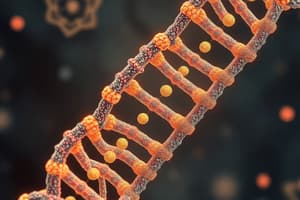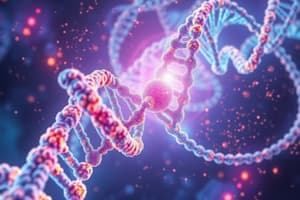Podcast
Questions and Answers
How does DNA supercoiling impact the accessibility of DNA regions to enzymes and proteins?
How does DNA supercoiling impact the accessibility of DNA regions to enzymes and proteins?
- It decreases the accessibility of DNA regions
- It has no effect on accessibility
- It enhances the accessibility of DNA regions (correct)
- It only affects non-essential cellular processes
Which cellular processes does DNA supercoiling play a crucial role in?
Which cellular processes does DNA supercoiling play a crucial role in?
- Cellular respiration
- Growth and development
- Transcription, replication, recombination, and chromosome segregation (correct)
- Metabolic processes
What is the significance of topoisomerases in relation to DNA supercoiling?
What is the significance of topoisomerases in relation to DNA supercoiling?
- Topoisomerases prevent negative supercoiling
- Topoisomerases have no relation to DNA supercoiling
- Topoisomerases regulate DNA supercoiling levels (correct)
- Topoisomerases are responsible for overwrapping DNA
In the context of DNA supercoiling, what does positive supercoiling refer to?
In the context of DNA supercoiling, what does positive supercoiling refer to?
How does negative supercoiling affect gene expression?
How does negative supercoiling affect gene expression?
What is the approximate number of base pairs represented by one turn of the DNA helix in the context of supercoiling?
What is the approximate number of base pairs represented by one turn of the DNA helix in the context of supercoiling?
What is the main function of topoisomerases?
What is the main function of topoisomerases?
Which type of topoisomerase creates double-stranded breaks and unwinds an entire segment of DNA?
Which type of topoisomerase creates double-stranded breaks and unwinds an entire segment of DNA?
What is the significance of negative supercoiling in gene expression?
What is the significance of negative supercoiling in gene expression?
How do changes in DNA supercoiling influence gene expression?
How do changes in DNA supercoiling influence gene expression?
Which statement is true regarding the essentiality of topoisomerases?
Which statement is true regarding the essentiality of topoisomerases?
Why do cells need to control the degree of supercoiling?
Why do cells need to control the degree of supercoiling?
Study Notes
DNA Supercoiling: Understanding the Twists and Turns of Genetic Information
Deoxyribonucleic acid (DNA) is the molecular blueprint of life, carrying genetic instructions from generation to generation. However, not all genetic information is encoded in the linear sequence of nucleotide bases. An additional layer of complexity comes from the twisting of DNA around itself, known as DNA supercoiling. This intricate structure plays a crucial role in various cellular processes, such as transcription, replication, recombination, and chromosome segregation. Let's delve deeper into the intricacies of DNA supercoiling, focusing on its biological significance, the role of topoisomerases, positive and negative supercoiling, and its effects on gene expression.
DNA Supercoiling: An Overview
Supercoiling refers to the winding or unwinding of DNA strands around each other. In the context of DNA supercoiling, one turn of the DNA helix represents approximately 10.4 base pairs. The degree of supercoiling, whether it is underwrapped (negative supercoiling) or overwrapped (positive supercoiling), affects the accessibility of DNA regions to enzymes and proteins responsible for essential cellular processes.
Biological Significance
DNA supercoiling is a fundamental regulatory principle in the control of various cellular functions. It acts as a physical barrier that modulates access to genomic information, ensuring proper regulation of gene expression and maintaining the stability of chromosomes during replication. Supercoiling patterns are also crucial for preserving the integrity of genetic material during DNA repair processes. By controlling the degree of supercoiling, cells can fine-tune their response to environmental stimuli and maintain the overall balance of a healthy organism.
Topoisomerases: The Unravelers
Topoisomerases are enzymes that manipulate DNA strands by introducing transient breaks, allowing them to change the topology of DNA molecules without affecting their base sequence. There are two main classes of topoisomerases: Type I and Type II. Type I topoisomerases introduce a single-strand break into duplex DNA and pass one strand through a second break on the same or another molecule of DNA, thus changing the supercoiling level. On the other hand, Type II topoisomerases, such as DNA gyrase, create double-stranded breaks, unwind an entire segment of DNA, and then rejoin the ends after passing another segment of DNA through the gap. In some cases, these enzymes can perform both types of reactions. Different species have different combinations of topoisomerases with varying roles and specificities.
Essentiality of Topoisomerases
The essentiality of many topoisomerases implies that they must be present at least at a basal level all of the time. However, some topoisomerases are regulated according to their function, with their expression tuned in response to specific signals. For example, eukaryotic Topo I is constitutively expressed but activated by polyamines, whereas archaea possess topoisomerases that are induced by relaxed DNA. These variations in expression ensure that DNA supercoiling levels remain optimal for cell survival and efficient gene expression.
Positive and Negative Supercoiling
Supercoils can either underwind (negative supercoiling) or overwind (positive supercoiling) DNA around itself. Negative supercoiling occurs when there are more than one turn per 10.4 base pairs, while positive supercoiling indicates fewer turns per 10.4 base pairs. Both negative and positive supercoiling play important roles in regulating gene expression and DNA metabolism.
Effects on Gene Expression
Changes in DNA supercoiling influence gene expression by altering the accessibility of promoters and enhancers to RNA polymerase and other transcription factors. Some genes exhibit enhanced expression when DNA is relaxed, while others require negative supercoiling for full activation. This differential response suggests that DNA supercoiling acts as a molecular switch to fine-tune gene expression patterns according to the needs of a given cell or developmental stage.
Conclusion
DNA supercoiling is an essential aspect of DNA structure and function, controlling various cellular processes across all domains of life. The regulation of topoisomerases that introduce positive or negative supercoils appears to be domain-specific, with bacteria and archaea exhibiting unconstrained global supercoiling. Further research into the evolutionary history of these enzymes may shed light on their roles in early cellular life and their potential for therapeutic applications targeting bacterial-specific mechanisms. Understanding the intricate relationship between DNA supercoiling and gene expression will continue to be a fruitful area of investigation, providing insights into the complex machinery of genetic information processing.
Studying That Suits You
Use AI to generate personalized quizzes and flashcards to suit your learning preferences.
Description
Test your knowledge on DNA supercoiling, including its biological significance, the role of topoisomerases, positive and negative supercoiling, and effects on gene expression. Explore the twists and turns of genetic information at a molecular level.




